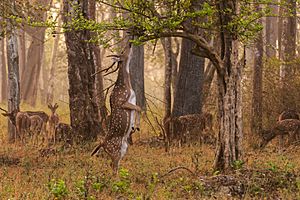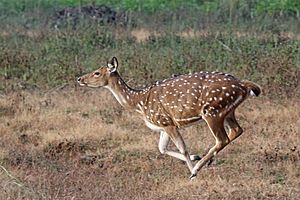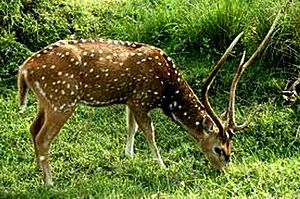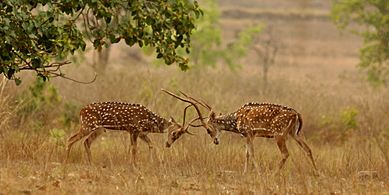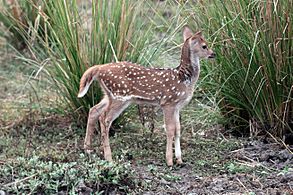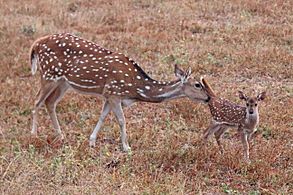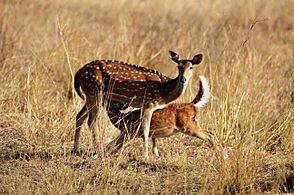Chital facts for kids
Quick facts for kids Chital |
|
|---|---|
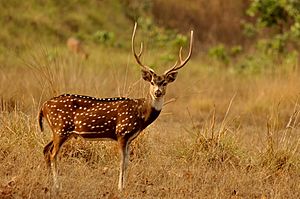 |
|
| Stag | |
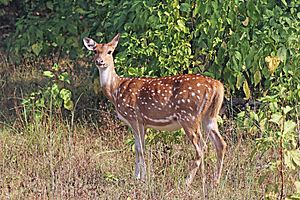 |
|
| Doe both in Kanha National Park at the Madhya Pradesh |
|
| Conservation status | |
| Scientific classification | |
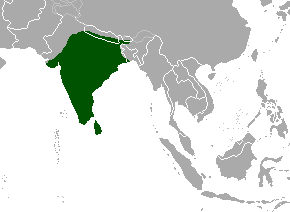 |
|
| Distribution of chital (2011) | |
| Synonyms | |
The chital (Axis axis), also known as spotted deer or axis deer, is a type of deer that lives in the Indian subcontinent. A German scientist named Johann Christian Polycarp Erxleben first described it in 1777.
Chital are medium-sized deer. Male chital can stand about 90 cm (35 in) tall at the shoulder. Females are a bit smaller, around 70 cm (28 in) tall. Males weigh between 30 and 75 kg (66 and 165 lb). Females are lighter, weighing 25 to 45 kg (55 to 99 lb).
Male chital are larger than females. Only males have antlers. Their fur is golden to reddish-brown with many white spots. Their belly, rump, throat, and the inside of their legs, ears, and tail are all white. The antlers have three points and can be nearly 1 meter (3.3 ft) long.
Contents
What's in a Name?
The name "chital" comes from the Sanskrit word citrala. This word means "variegated" or "spotted." The name of the cheetah cat comes from a similar origin. Other common names for this deer include Indian spotted deer and axis deer.
Chital's Family Tree
The chital was first described as Cervus axis in 1777. Later, in 1827, a scientist named Charles Hamilton Smith put the chital into its own group called Axis. This group eventually became known as a genus.
Scientists have studied how chital are related to other deer. They found that the chital is closely related to the Barasinga deer. They believe the chital separated from its relatives about five million years ago.
What Does a Chital Look Like?
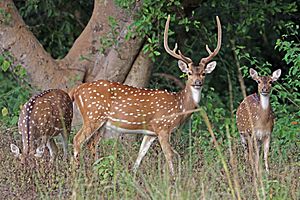
The chital is a medium-sized deer. Males are about 90 cm (35 in) tall at the shoulder. Females are about 70 cm (28 in) tall. Their body length is around 1.7 meters (5.6 ft). Young males weigh 30 to 75 kg (66 to 165 lb). Females weigh 25 to 45 kg (55 to 99 lb). Adult males can weigh up to 110 kg (240 lb).
Their tail is about 20 cm (7.9 in) long. It has a dark stripe along its top. Males are bigger than females. Only males grow antlers.
The upper part of their body is golden to reddish-brown. It is completely covered in white spots. Their belly, rump, throat, and the inside of their legs, ears, and tail are white. A clear black stripe runs along their back. Chital have special glands near their eyes called preorbital glands. These glands are larger in males. They also have glands on their hind legs.
Each antler has three points. The first point, called the brow tine, sticks out almost straight from the main antler. The antlers can grow up to 1 meter (3.3 ft) long. Like most deer, chital shed their antlers every year. New antlers grow as soft tissue, then harden into bone.
Chital hooves are between 4.1 and 6.1 cm (1.6 and 2.4 in) long. Their front hooves are longer than their back ones. Their teeth are similar to an elk. Young chital lose their milk canine tooth before they are one year old. Unlike other deer, a permanent tooth does not grow in its place.
Chital look similar to fallow deer. However, chital have many clear white spots. Fallow deer usually have white blotches. Chital have three distinct points on each antler. Fallow deer have flatter, palmate antlers. A big difference is the dark brown stripe running down the chital's back. Chital also have a clear white patch on their throat.
Daily Life and Habits
Chital are active all day. In summer, they rest in the shade when it's hot. They are most active as evening approaches. When it's cooler, they start looking for food before sunrise. They slow down in the middle of the day, resting or moving slowly. They start eating again in the late afternoon and continue until midnight. They usually sleep in the forest before sunrise.
When they travel, chital often walk in a single line. They keep a distance of two to three times their body width between them. This helps them find food and water. Studies show that chital travel the most during summer.
How Chital Avoid Danger
When a chital senses danger, it stands still and listens carefully. Other deer nearby might do the same. To escape predators, chital run away in groups. They do not scatter like some other deer. When running, they raise their tail, showing its white underside. Chital can jump over fences up to 1.5 meters (4.9 ft) high. But they prefer to go under them. They usually stay within 300 meters (980 ft) of dense cover.
Chital's Social Life
Chital are social animals. They live in groups called herds. A common herd is a mother and her young from this year and last year. These groups can mix with other chital of any age or sex. There are also male-only herds and herds of young deer with their mothers. Small herds are common. Sometimes, groups of up to 100 chital have been seen.
Herds are not very strict and often break apart. Only the mother-young herd stays together. In India, herds can have 5 to 40 members. The number of males and females in herds can change with the seasons. Females sometimes leave the herd before giving birth. Males also leave their herds during mating season. Large herds are most common during the monsoon season. They are often seen eating in grasslands.
Chital predators include wolves, Bengal tigers, Asiatic lions, leopards, Indian rock pythons, dholes, and mugger crocodiles. Young chital are sometimes hunted by Red foxes and golden jackals. Male chital are less likely to be caught than females and young deer.
Chital Sounds and Communication
Chital are very vocal animals. They make loud calls and alarm barks. Their calls are not as strong as those of elk. They are mostly rough bellows or loud growls. Males bellow more during mating season. Dominant males protecting females make high-pitched growls at other males. Males might also moan when showing aggression or resting.
Chital, especially females and young, bark loudly when they are alarmed or see a predator. Young chital looking for their mothers often squeal. Chital can also understand the alarm calls of other animals, like common myna birds and langur monkeys.
Special Habits: Marking and Friends
Male chital often mark their territory. They have well-developed glands near their eyes. They stand on their back legs to reach tall branches. Then they rub these glands to leave their scent. They also use this posture when eating. Chital also mark with urine. The smell of urine is usually stronger than the scent from their glands.
Fights between males often start with the larger male showing off. He might hiss, turn his tail towards the other male, point his nose down, lower his ears, and raise his upper lip. His fur might stand up. He then slowly walks towards the other male. Males with soft antlers might hunch over instead of standing tall. The males then lock their antlers together and push. The smaller male might make a loud sound. Fights usually are not serious. They end when one male steps back or just leaves.
Chital sometimes bite each other. Common myna birds are often seen near chital. An interesting relationship exists between chital herds and northern plains grey langur monkeys. Chital benefit from the langurs' good eyesight and their ability to watch from trees. Langurs benefit from the chital's strong sense of smell. Both help each other spot danger. Chital also eat fruits dropped by langurs from trees. Chital have also been seen eating with sambar deer.
What Do Chital Eat?
Chital eat both grasses and leaves/twigs. They mainly eat grasses all year. They prefer young grass shoots. If young grass is not available, they nibble the tips of tall, rough grasses. Eating leaves, shrubs, and fruits becomes a bigger part of their diet in winter. This is when grasses are tall or dried up and not as tasty.
Fruits eaten by chital in Kanha National Park include figs from January to May. They eat Cordia myxa fruits from May to June. They also eat Syzygium cumini fruits from June to July. Chital often gather to eat slowly. They are usually quiet when grazing together. Males sometimes stand on their hind legs to reach high branches. They visit water holes about twice a day, being very careful. In Kanha National Park, chital also scrape at mineral licks. These licks are rich in calcium and phosphorus. Chital in the Sundarbans might even eat meat. Remains of red crabs have been found in their stomachs.
Reproduction and Life Cycle
Chital can breed all year round. The peak breeding times vary depending on the area. Males produce sperm throughout the year. Females have regular cycles that last three weeks. A female can get pregnant again two weeks to four months after giving birth.
Males with hard antlers are dominant over those with soft antlers or no antlers. Courtship involves the male following and guarding a female ready to mate. The pair will chase each other and lick each other before mating.
A newborn chital is hidden for about a week after birth. This is a much shorter time than for most other deer. The bond between mother and fawn is not very strong. They often get separated but can easily find each herd again. If a fawn dies, the mother can breed again to have two births in one year. Males continue to grow until they are seven to eight years old. In zoos, chital can live for about 22 years. In the wild, they usually live for only five to ten years.
Chital are found in large numbers in dense forests and open grasslands. The most chital live in the forests of India. They eat tall grass and shrubs there. Chital have also been seen in Phibsoo Wildlife Sanctuary in Bhutan. This sanctuary has the only natural sal forest left in the country. Chital do not live in high mountains. Other deer like the sambar deer live there instead. Chital prefer areas with heavy forest cover for shade. They avoid direct sunlight.
Where Do Chital Live?
The chital lives across India, Nepal, Bhutan, Bangladesh, and Sri Lanka. Its western range is in eastern Rajasthan and Gujarat. To the north, it lives along the foothills of the Himalayas. This includes parts of Uttar Pradesh, Uttarakhand, Nepal, northern West Bengal, Sikkim, western Assam, and the forested valleys of Bhutan below 1,100 meters (3,600 ft).
Its eastern range goes through western Assam to the Sundarbans in West Bengal (India) and Bangladesh. Sri Lanka is its southern limit. Chital are also found in other forested areas across the Indian peninsula. In Bangladesh, they now only live in the Sundarbans and some special parks. They used to live in central and northeast Bangladesh but are now gone from those areas.
Chital Around the World
Chital have been introduced to other parts of the world.
Chital in Australia
Chital were first brought to Australia in the early 1800s. Dr. John Harris brought about 400 of them. However, these deer did not survive. Now, chital are mainly found on some cattle farms in North Queensland. There are also wild herds on the north coast of New South Wales. Some of these deer came from Sri Lanka, and some from India.
Chital in the United States
In the 1860s, chital were brought to Molokai, Hawaii. They were a gift to King Kamehameha V. Soon after, they were brought to Lanai, another Hawaiian island. Now, there are many chital on both islands. In the 1950s, they were brought to Maui island for hunting.
Because there are no natural predators for the deer in Hawaii, their population grows quickly. It increases by 20 to 30% each year. This causes serious damage to farms and natural areas. There were plans to release them on the island of Hawaii. But scientists stopped this because of the damage they caused on other islands. In 2012, chital were seen on the island of Hawaii. Wildlife officials believe people brought them there by helicopter and boat. Now, Hawaiian law does not allow moving wild deer between islands.
In 1932, chital were brought to Texas. By 1988, wild herds were found in 27 counties in Central and South Texas. They are most common on the Edwards Plateau. This area is similar to their home in India.
Chital in Croatia
Chital were brought to Brijuni Island in 1911. They still live there today. They can also be found on Rab Island. About 200 chital live on these two islands. Attempts to bring them to the mainland of Croatia by hunters were not successful.
Protecting the Chital
The IUCN lists the chital as being of "Least Concern". This means they are not currently at high risk of extinction. They live in a very large area and have many big populations.
Right now, there are no major threats to chital across their whole range. They live in many protected areas. However, in some places, their numbers are lower than they could be. This is due to hunting and competition with farm animals. Hunting for their meat has caused their numbers to drop a lot in some areas. The chital is protected by law in India and Bangladesh. Its good conservation status is mainly because it is legally protected and lives in many well-managed protected areas.
Chital have been introduced to many places. These include the Andaman Islands, Argentina, Australia, Brazil, Chile, Mexico, Paraguay, Uruguay, and several states in the United States like Alabama, California, Florida, Hawaii, Mississippi, and Texas. They are also on the Veliki Brijun Island in Croatia.
Gallery
-
Spotted deer near Coimbatore
-
Herd grazing while one (on left) keeps watch at Sudarnakhali, Sundarbans
See also
 In Spanish: Axis axis para niños
In Spanish: Axis axis para niños



